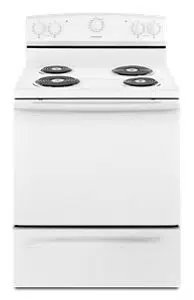Documents: Go to download!
User Manual
- User Manual - (English)
- Installation Instruction - (English)
- Quick Start Guide - (English)
- Specification - (English)
- COOKTOP USE
- OVEN USE
- RANGE CARE
- TROUBLESHOOTING
Table of contents
Owner Manual ELECTRIC RANGE
COOKTOP USE
WARNING - Fire Hazard
- Turn off all controls when done cooking.
- Failure to do so can result in death or fire.
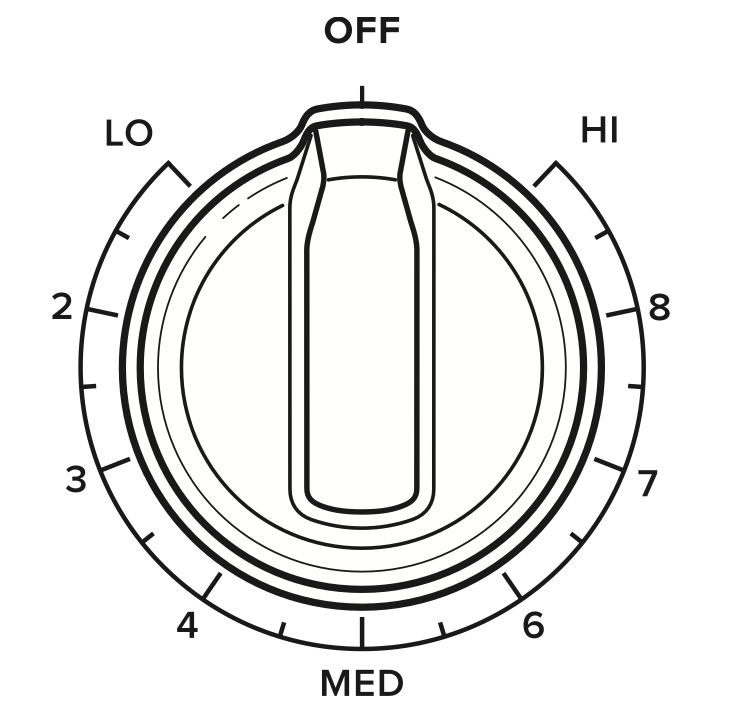
The control knobs can be set to anywhere between HI and LO. Push in and turn to setting.
REMEMBER: When cooktop is in use, the entire cooktop area may become hot.
Coil Elements and Burner Bowls
Coil elements should be level for optimal cooking results. Burner bowls, when clean, reflect heat back to the cookware. They also help catch spills.
Cookware should not extend more than ½" (1.3 cm) over the coil element. If cookware is uneven or too large, it can produce excess heat, causing the burner bowl to change color.
Cooktop On Indicator Light
The Cooktop On indicator light is located on the console panel. When any control knob on the console panel is turned on, the Cooktop On indicator light will glow.
Cookware
IMPORTANT: Do not leave empty cookware on a hot surface cooking area, element or surface burner.
Ideal cookware should have a flat bottom, straight sides and a well-fitting lid, and the material should be of medium-to-heavy thickness.
Rough finishes may scratch the cooktop. Aluminum and copper may be used as a core or base in cookware. However, when used as a base, they can leave permanent marks on the surfaces.
Cookware material is a factor in how quickly and evenly heat is transferred, which affects cooking results. A nonstick finish has the same characteristics as its base material. For example, aluminum cookware with a nonstick finish will take on the properties of aluminum.
Cookware with nonstick surfaces should not be used under the broiler.
Check for flatness by placing the straight edge of a ruler across the bottom of the cookware. While you rotate the ruler, no space or light should be visible between it and the cookware.
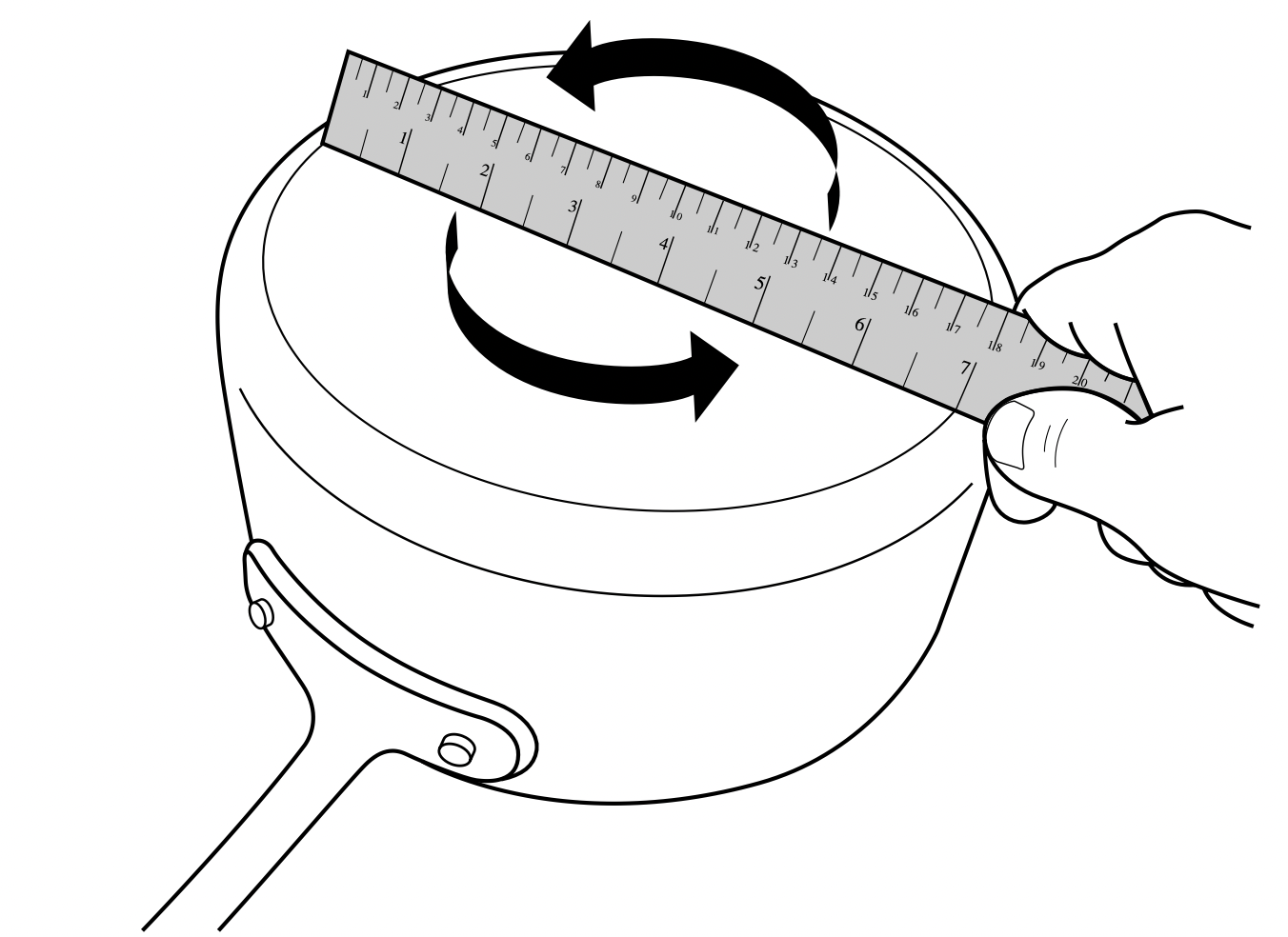
Use the following chart as a guide for cookware material characteristics.
| Cookware | Characteristics |
|---|---|
| Aluminum |
|
| Cast iron |
|
| Ceramic or Ceramic glass |
|
| Copper |
|
| Earthenware |
|
| Porcelain enamelon-steel or cast iron |
|
| Stainless steel |
|
Use flat-bottomed cookware for best cooking results and energy efficiency. The cookware should be about the same size as the cooking area outlined on the cooktop. Cookware should not extend more than ½" (1.3 cm) outside the area.
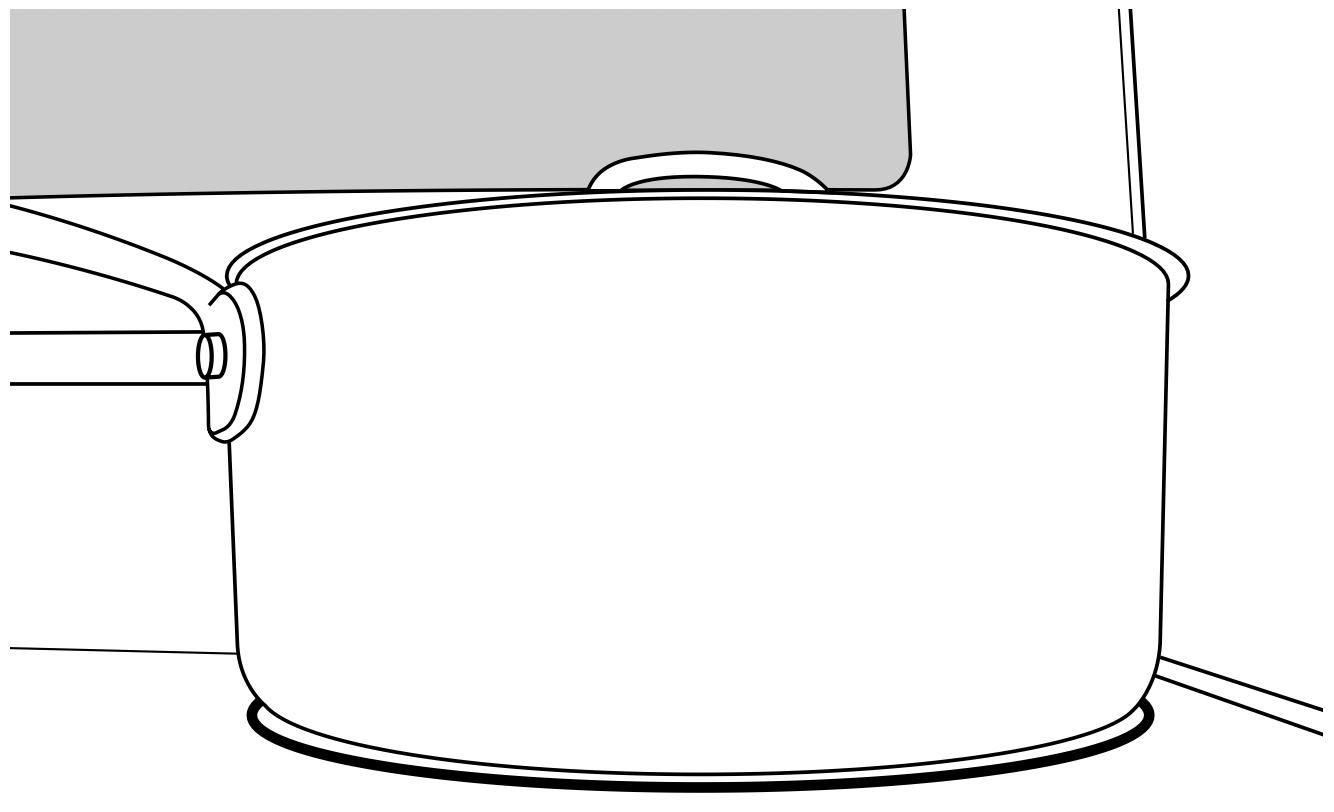
Home Canning
Canning can be performed on a glass smooth top cooking surface or traditional coil element cooktop. When canning for long periods, alternate the use of surface cooking areas or elements between batches. This allows time for the most recently used areas to cool.
- Center the canner on the largest surface cooking area or element. On electric cooktops, canners should not extend more than ½" (1.3 cm) beyond the surface cooking area or element.
- Do not place canner on 2 surface cooking areas or elements at the same time.
- On ceramic glass models, use only flat-bottomed canners to avoid damage to the cooktop and elements.
- For more information, contact your local agricultural extension office, or refer to published home canning guides. Companies that manufacture home canning products can also offer assistance.
OVEN USE
Odors and smoke are normal when the oven is used the first few times or when it is heavily soiled.
IMPORTANT: The health of some birds is extremely sensitive to the fumes given off. Exposure to the fumes may result in death to certain birds. Always move birds to another closed and wellventilated room.
Oven Light Switch (on some models)
The oven light switch is located on the top left corner of the range.
Oven Heating Indicator Light
The Oven Heating indicator light, located on the console panel, will glow when either the Bake or Broil function is turned on.
Aluminum Foil
IMPORTANT: To avoid permanent damage to the oven bottom finish, do not line the oven bottom with any type of foil or liner.
For best cooking results, do not cover entire oven rack with foil because air must be able to move freely.
Positioning Racks and Bakeware
IMPORTANT: To avoid permanent damage to the porcelain finish, do not place food or bakeware directly on the oven door or bottom.
Bakeware
To cook food evenly, hot air must be able to circulate. Allow 2" (5 cm) of space around bakeware and oven walls. Make sure that no bakeware piece is directly over another.
Racks
- Position racks before turning on the oven.
- Do not move racks with bakeware on them.
- Make sure racks are level.
To move a rack, pull it out to the stop position, raise the front edge, and then lift out. Use the following illustration and charts as a guide.
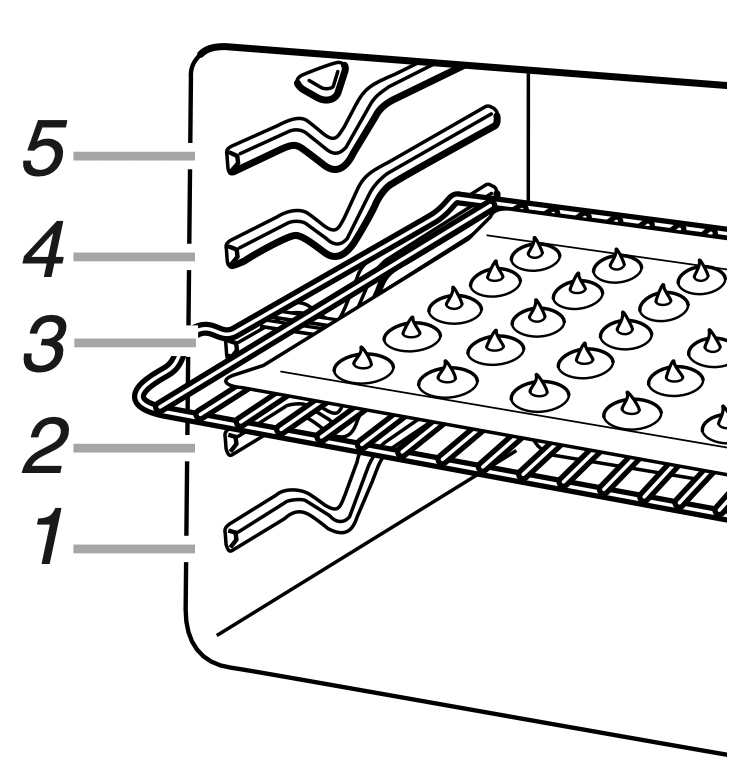
Rack Positions
Rack 5: Toasting bread or broiling thin, non-fatty foods.
Rack 4: Use for 2-rack baking and broiling.
Rack 3: Most baked goods on a cookie sheet or jelly roll pan, layer cakes, frozen convenience foods; broiling chicken pieces.
Rack 2: Roasting small cuts of meat, pies, casseroles, bundt cakes, and 2-rack baking.
See other models: AEP222VAW NEC3120FW NEC3240FW NGD4655EW NED4655EW
Rack 1: Roasting large cuts of meat and poultry.
Multiple Rack Cooking
2-rack: Use rack positions 2 and 4.
Baking Layer Cakes on 2 Racks
For best results when baking cakes on 2 racks, use racks 2 and 4 for baking. Place the cakes on the racks as shown.
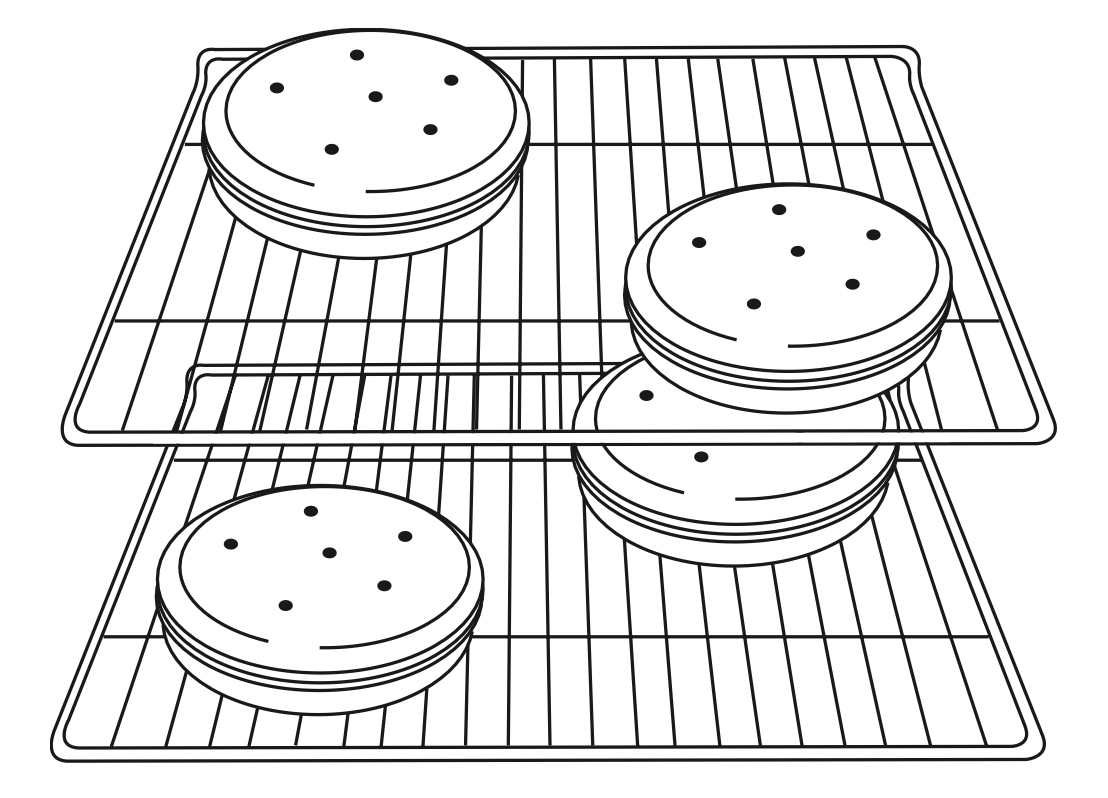
Baking Cookies on 2 Racks
For best results when baking cookies on 2 racks, use racks 2 and 4 for baking.
Oven Vent
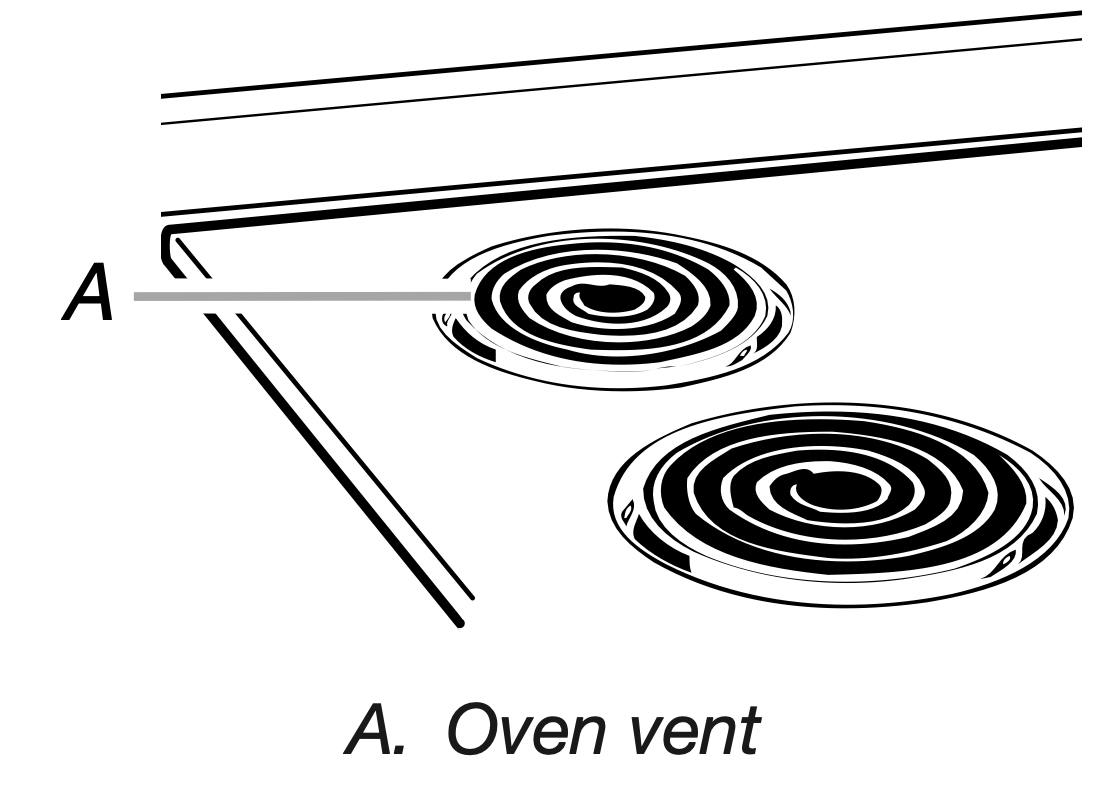
The oven vent releases hot air and moisture from the oven and should not be blocked or covered. Blocking or covering vent will cause poor air circulation, affecting cooking and cleaning results. Do not set plastics, paper, or other items that could melt or burn near the oven vent.
The element can be used when the oven is in use as long as the cookware does not extend more than ¹⁄2 " (1.3 cm) over the element.
Baking and Roasting
Before baking and roasting, position the racks according to the “Positioning Racks and Bakeware” section. When roasting, it is not necessary to wait for the oven to preheat before putting food in, unless recommended in the recipe.
Oven Temperature
While in use, the oven elements will cycle on and off as needed to maintain a consistent temperature, but they may run slightly hot or cool at any point in time due to this cycling. Opening the oven door while in use will release the hot air and cool the oven which could impact the cooking time and performance. It is recommended to use the oven light to monitor cooking progress.
To Bake or Roast:
- Push in and turn the oven control knob to the desired temperature setting. The Oven Heating light will turn on and remain on until the oven reaches the set temperature.
- Place food in oven. The bake element will turn on and off to maintain cooking temperature. The Oven Heating light will turn on and off with the element.
- Turn oven control knob to OFF when finished.
Broiling
Leave the door open at the broil stop position to ensure proper broiling temperature. Preheat the oven for 5 minutes before putting food in unless recommended otherwise in the recipe. Position food on grid in a broiler pan, and then place it in the center of the oven rack.
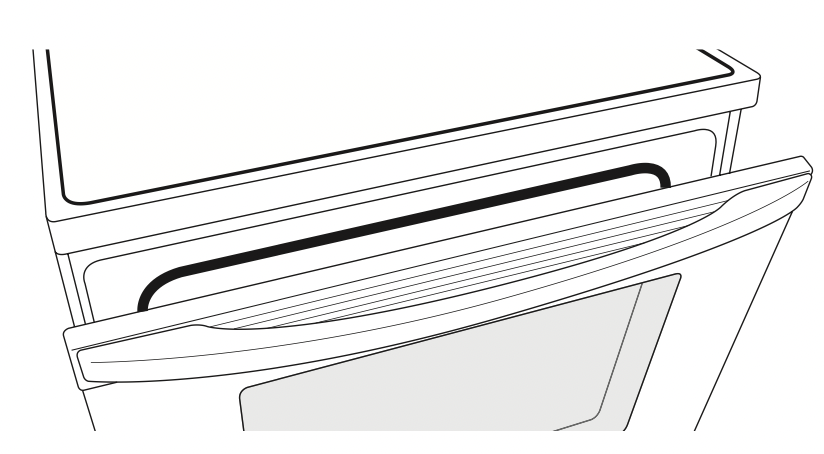
NOTE: Odors and smoke are normal the first few times the oven is used or if the oven is heavily soiled.
Changing the temperature when broiling allows more precise control when cooking. The lower the broil setting, the slower the cooking. Thicker cuts and unevenly shaped pieces of meat, fish and poultry may cook better at lower broil settings. Use racks 4 or 5 for broiling. Refer to the “Positioning Racks and Bakeware” section for more information.
On lower settings, the broil element will cycle on and off to maintain the proper temperature.
- For best results, use a broiler pan and grid. It is designed to drain juices and help avoid spatter and smoke.
If you would like to purchase a broiler pan, one may be ordered. Please refer to the “Accessories” section for more information.
RANGE CARE
General Cleaning
IMPORTANT: Before cleaning, make sure all controls are OFF and the oven and cooktop are cool. Always follow label instructions on cleaning products.
Soap, water, and a soft cloth or sponge are suggested first unless otherwise noted.
EXTERIOR PORCELAIN ENAMEL SURFACES (on some models)
Food spills containing acids, such as vinegar and tomato, should be cleaned as soon as the entire range is cool. These spills may affect the finish.
Cleaning Method:
- Glass cleaner, mild liquid cleaner, or nonabrasive scrubbing pad:
Gently clean around the model and serial number plate because scrubbing may remove numbers. - affresh ® Kitchen and Appliance Cleaner Part Number W10355010 (not included):
See cover for contact information.
METALLIC PAINT (on some models)
Do not use abrasive cleaners, cleaners with bleach, rust removers, ammonia, or sodium hydroxide (lye) because paint surface may stain.
COOKTOP CONTROLS
To avoid damage to the cooktop controls, do not use steel wool, abrasive cleansers, or oven cleaner.
Do not soak knobs. When replacing knobs, make sure knobs are in the OFF position.
On some models, do not remove seals under knobs.
Cleaning Method:
- Soap and water:
Pull knobs straight away from control panel to remove.
CONTROL PANEL AND OVEN DOOR EXTERIOR
To avoid damage to the control panel, do not use abrasive cleaners, steel-wool pads, gritty washcloths, or abrasive paper towels.
Cleaning Method:
- Glass cleaner and soft cloth or sponge:
Apply glass cleaner to soft cloth or sponge, not directly on panel. - affresh ® Kitchen and Appliance Cleaner Part Number W10355010 (not included):
See cover for contact information.
COIL ELEMENTS (on some models)
Cleaning Method:
- Damp cloth: Make sure control knobs are OFF and elements are cool.
Do not clean or immerse in water. Soil will burn off when hot.
BURNER BOWLS (on some models)
Before removing or replacing coil elements and burner bowls, make sure they are cool and the control knobs are in the OFF position.
Remove the coil element by pushing the edge of the coil element toward the receptacle. Lift it enough to clear the burner bowl. Pull the coil element straight away from the receptacle to remove. Lift out the burner bowl.
Cleaning Method:
Chrome burner bowls
Wash frequently in warm, soapy water. (It is not recommended to wash chrome bowls in a dishwasher.) A mild abrasive cleaner and a plastic scrubber can be used to remove stubborn stains.
For heavily soiled bowls, place an ammonia-soaked paper towel on the stains and allow to soak for a short time, then gently scrub with a plastic scrubber.
SURFACE UNDER COOKTOP (on some models)
The coil cooktop will lift up to provide easy access for cleaning beneath. Lift the cooktop by both front corners until the support locks into place.
Cleaning Method:
- Glass cleaner, mild liquid cleaner or nonabrasive scrubbing pad.
- affresh ® Kitchen and Appliance Cleaner Part Number W10355010 (not included):
See cover for contact information.
To avoid damage to the range, do not remove the cooktop.
OVEN CAVITY
Food spills should be cleaned when oven cools. At high temperatures, foods react with porcelain. Staining, etching, pitting or faint white spots can result.
Nonabrasive plastic scrubbing pad and mildly abrasive cleanser can be used on a cool cavity.
If using commercial oven cleaners, follow package directions.
OVEN RACKS
Cleaning Method:
- Steel-wool pad
- For racks that have discolored and are harder to slide, a light coating of vegetable oil applied to the rack guides will help them slide.
STORAGE DRAWER
Check that storage drawer is cool and empty before cleaning.
Cleaning Method:
- Mild detergent
Oven Light (on some models)
The oven light is a standard 40-watt appliance bulb. Before replacing, make sure the oven and cooktop are cool and the control knobs are in the OFF position.
To Replace:
- Unplug range or disconnect power.
- Turn the glass bulb cover in the back of the oven counterclockwise to remove.
- Turn bulb counterclockwise to remove from socket.
- Replace bulb, then bulb cover by turning clockwise.
- Plug in range or reconnect power.
TROUBLESHOOTING
| Problem |
Possible Causes and/or Solutions |
|---|---|
| Nothing will operate |
Power supply cord is unplugged: Plug into a grounded outlet. Household fuse is blown or a circuit breaker is tripped: Replace the fuse or reset the circuit breaker. If the problem continues, call an electrician. |
|
Cooktop will not operate |
The control knob is not set correctly: Push in knob before turning to a setting. |
| Excessive heat around cookware on cooktop |
The cookware is not the proper size: Use cookware about the same size as the surface cooking area, element, or surface burner. Cookware should not extend more than ½" (1.3 cm) outside the cooking area. |
| Cooktop cooking results not what expected |
Control knob set to incorrect heat level: See “Cooktop Use” section. Range is not level: Level the range. See the Installation Instructions. |
|
Oven temperature too high or too low |
Oven temperature calibration needs adjustment: See “Oven Use” section. |
| Oven cooking results not what expected |
Range is not level: Level the range. See the Installation Instructions. Improper temperature set: Double-check the recipe in a reliable cookbook. Improper oven temperature calibration set: See “Oven Use” section. Racks positioned improperly: See “Positioning Racks and Bakeware” section. Improper air circulation around bakeware: See “Positioning Racks and Bakeware” section. Batter unevenly distributed in the pan: Check that batter is level in the pan. Improper length of time being used: Adjust cooking time. Oven door has been opened while cooking: Oven peeking releases oven heat and can result in longer cooking times. Baked items are too brown on the bottom: Move rack to higher position in the oven. Pie crust edges are browning early: Use aluminum foil to cover the edge of the crust and/or reduce baking temperature. |
